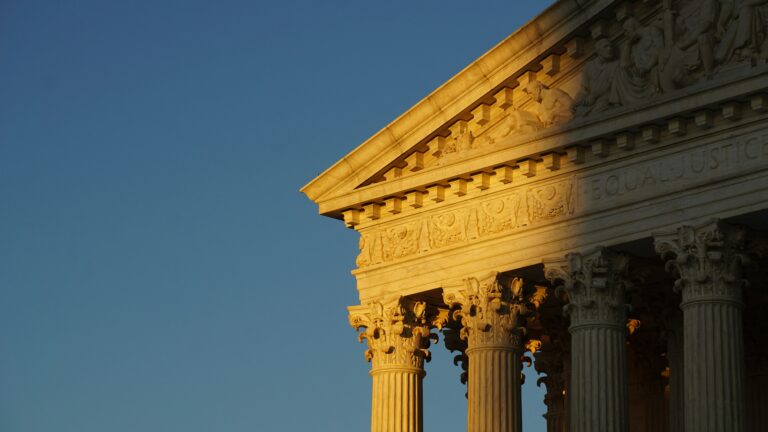Jenny Samuels is a student at Harvard Law School and a member of the Labor and Employment Lab.
Employment relationships have long been a central battleground in conflicts over religious freedom. This should not come as a surprise: entering into an employment relationship necessarily entails both employers and employees ceding certain freedoms at the shop door. An employer must pay taxes, provide a wage and benefits, and abide by antidiscrimination law. An employee must work at scheduled times, present themselves in a manner determined by the employer, and provide a service for customers. When these requirements bump up against religious beliefs, serious questions emerge as to when those beliefs must be accommodated, and to what extent nonadherents should be forced to bear the brunt of others’ spiritual inclinations.
For decades, the Supreme Court’s approach to such conflicts was characterized by a “third-party harm” principle, which limited religious accommodations and exemptions where they imposed harms on non-objecting third parties. More recently, however, both the types of religious objections being raised and the Court’s response to them have undergone a marked shift. First, religious objectors are increasingly bringing claims based on what Professors Douglas NeJaime and Reva Siegel have termed a “complicity” theory, in which a religious adherent objects “to being made complicit in the assertedly sinful conduct of others.” Second, after taking small steps away from the third-party harm principle, the conservative-dominated Court now appears eager to jettison it in its entirety. Both of these developments, operating in tandem, threaten to upend everything from employee autonomy outside the workplace to basic civil rights protections.
The Rise of Complicity Claims and Fall of the Third-Party Harm Principle
The Supreme Court historically dealt with religious objections by balancing appeals to religious freedom against the resulting harm of exemptions. In cases arising out of the employment context, the Court was especially sensitive to the potential for third-party harms, and made sure to limit exemptions so as to protect the interests of other parties to the employment relationship.
In the 1982 case, United States v. Lee, for example, the Court rejected an Amish employer’s claim for a religious exemption to the payment of social security taxes on the grounds that the requested exemption would impermissibly “operate[] to impose the employer’s religious faith on the employees.” In 1985, the Court heard Estate of Thornton v. Caldor, a case concerning a state law that gave religious employees the right to not work on their observed Sabbath. In striking down the law on Establishment grounds, the Court voiced similar concerns as it had in Lee — that the law would allow religious employees to levy “substantial economic burdens” on employers and that “the employer’s compliance would require the imposition of significant burdens on other employees required to work in place of the Sabbath observers.” Quoting Learned Hand, the Court reaffirmed a “fundamental principle of the Religion Clauses”: “The First Amendment . . . gives no one the right to insist that in pursuit of their own interests others must conform their conduct to his own religious necessities.”
After decades of relative stability, the Court’s religion jurisprudence began to mutate as it expansively interpreted the 1993 Religious Freedom Restoration Act. In particular, the Court’s 2014 decision in Burwell v. Hobby Lobby Stores marked a turn away from the third-party harm principle and toward a religious exemption jurisprudence that was extremely deferential to the objectives of Christian conservatives. In Hobby Lobby, corporate employers argued that the Affordable Care Act’s contraceptive mandate violated their religious beliefs by forcing them to include contraceptive coverage in their employee insurance plans — even though the decision to actually obtain and use contraceptives was a private medical decision made by employees outside the workplace. By ruling for the employers, the Court tacitly accepted that challenges based on a “complicity” theory, wherein a religious objection is based on the conduct of others, can give rise to an actionable claim of religious discrimination. Further, the Court signaled a willingness to grant religious accommodations and exemptions that, in the past, would have been denied due to the impact on third parties. While the Court did premise its decision on the presumption that the granted accommodation would have “precisely zero” impact on employees, others point out that this promise was likely hollow since Congress would have then had to approve increased funding for contraceptives, which was never a realistic possibility.
In its most recent religious exemption case, Little Sisters of the Poor Saints Peter and Paul Home v. Pennsylvania, the Court took an even more dramatic step away from the third-party harm principle. In Little Sisters, the Court upheld the Trump Administration’s sweeping religious and moral exemptions to the contraceptive mandate, this time without any discussion of the detrimental impact on employees — 126,400 of whom, by the government’s own count, would immediately lose health insurance coverage for contraceptives. Instead, the Court brushed aside the third-party harm question as a mere “policy concern.”
While much can be read into Little Sisters’ disregard of third-party harms, ultimately that case did not force the Court to contend with the issue head on. That opportunity may arise as soon as this term when the Court — now with an even greater conservative majority — hears Fulton v. City of Philadelphia, a case about whether a Catholic foster agency that refuses to work with same-sex couples is entitled to a religious exemption from Philadelphia antidiscrimination law. If the Court rules in favor of Fulton’s religious objectors, as most expect it to, in doing so it will likely further weaken the third-party harm principle, if not abandon it entirely.
The Dangers of Religious Exemptions in the Employment Context
These developments in the Court’s jurisprudence pose unique threats in the employment context. First, the rise of complicity claims means that employers can exert control over aspects of employees’ lives that are far removed from the workplace. In addition to being allowed to exclude contraceptive coverage from employee health plans, employers recently also won the right to exclude insurance coverage for gender affirming care. The upshot of these decisions is that employers now have legal authority to meddle in private healthcare decisions of employees.
Second, without third-party harm as a limiting principle, employment-related religious exemptions could upend longstanding antidiscrimination protections. For example, the Court has never directly addressed whether religious employers are entitled to exemptions from Title VII; without the third-party harm theory, it isn’t clear what would prevent such an exemption. Protections against discrimination in public accommodations, a key victory of the civil rights movement, are also at risk if religious employers or employees can refuse to serve certain classes of customers.
The Supreme Court once recognized the distinctive risks attendant to religious exemptions in the employment context, and limited such exemptions so as to prevent harm to nonadherents. Now, urged in ever more extreme directions by its unquestioning acceptance of complicity claims, the Court seems to be rapidly moving toward a complete abandonment of any limits on religious exemptions. As a result, Learned Hand’s “fundamental principle” of religion — that religious belief “gives no one the right to insist that in pursuit of their own interests others must conform their conduct to his own religious necessities” — appears to be fading into an ever more distant memory.









Daily News & Commentary
Start your day with our roundup of the latest labor developments. See all
December 22
Worker-friendly legislation enacted in New York; UW Professor wins free speech case; Trucking company ordered to pay $23 million to Teamsters.
December 21
Argentine unions march against labor law reform; WNBA players vote to authorize a strike; and the NLRB prepares to clear its backlog.
December 19
Labor law professors file an amici curiae and the NLRB regains quorum.
December 18
New Jersey adopts disparate impact rules; Teamsters oppose railroad merger; court pauses more shutdown layoffs.
December 17
The TSA suspends a labor union representing 47,000 officers for a second time; the Trump administration seeks to recruit over 1,000 artificial intelligence experts to the federal workforce; and the New York Times reports on the tumultuous changes that U.S. labor relations has seen over the past year.
December 16
Second Circuit affirms dismissal of former collegiate athletes’ antitrust suit; UPS will invest $120 million in truck-unloading robots; Sharon Block argues there are reasons for optimism about labor’s future.